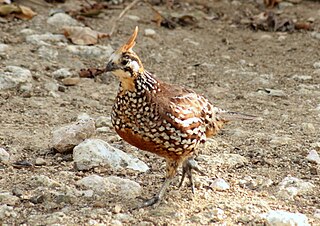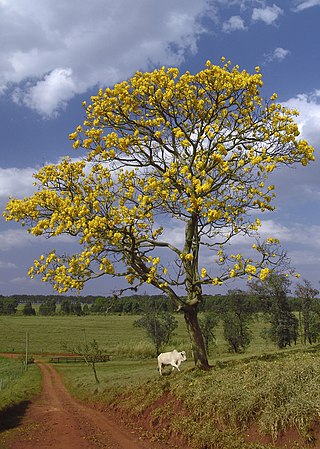
Tabebuia is a genus of flowering plants in the family Bignoniaceae. Tabebuia consists almost entirely of trees, but a few are often large shrubs. A few species produce timber, but the genus is mostly known for those that are cultivated as flowering trees.

The Cabo Blanco Absolute Natural Reserve is a Nature Reserve of Costa Rica, part of the Tempisque Conservation Area in the province of Puntarenas, covering an area of 3,140 acres (12.7 km2) terrestrial and 4,420 acres (17.9 km2) marine on the southern tip of the Nicoya Peninsula near Montezuma-Cabuya and Mal Pais.

Boa Esperança is a Brazilian municipality from the state of Minas Gerais. The municipality is located by the Serra da Boa Esperança, which became celebrated through song that brings its name, compounded by Lamartine Babo and performed by several singers. Across its territory passes Rio Grande, important to the development of the region. The economy of Boa Esperança is based on coffee plantations and tourism.

Manduca florestan, the Florestan sphinx, is a moth of the family Sphingidae. The species was first described by Caspar Stoll in 1782.

The short-eared bat is a bat species found in Brazil, Costa Rica, Guyana and Nicaragua. It is the only species within its genus.

The crested bobwhite is a species of bird in the family Odontophoridae. It is found in northern South America, extending through Panama to just reach Costa Rica. It also occurs on Aruba and the Netherlands Antilles. Its natural habitats are subtropical or tropical dry shrubland, subtropical or tropical seasonally wet or flooded lowland grassland, and heavily degraded former forest.

Manduca dilucida is a moth of the family Sphingidae first described by William Henry Edwards in 1887.

Tabebuia aurea is a species of Tabebuia native to South America in Suriname, Brazil, eastern Bolivia, Peru, Paraguay, and northern Argentina. The common English name Caribbean trumpet tree is misleading, as it is not native to the Caribbean. It is also known as the silver trumpet tree, and tree of gold.

Handroanthus chrysotrichus, synonym Tabebuia chrysotricha, commonly known as the golden trumpet tree, is a semi-evergreen/semi-deciduous tree from Brazil. It is very similar to and often confused with Tabebuia ochracea. In Portuguese it is called ipê amarelo and its flower is considered the national flower of Brazil.

Tabebuia rosea, also called pink poui, and rosy trumpet tree is a neotropical tree that grows up to 30 m (98 ft) and can reach a diameter at breast height of up to 100 cm (3 ft). The Spanish name roble de sabana, meaning "savannah oak", is widely used in Costa Rica, probably because it often remains in heavily deforested areas and because of the resemblance of its wood to that of oak trees. It is the national tree of El Salvador, where it is called "Maquilíshuat".
Jaíba Biological Reserve is a biological reserve in Minas Gerais, Brazil.

Enchophora sanguinea is a species of lantern bug, a type of hemipteran, found in Central and South America. It was first described by William Lucas Distant in 1887. They are 25 millimetres (1.0 in) long. Their colour varies, but is normally red to green; they have a scimitar-shaped process on their heads. They feed on the sap of trees, most commonly Simarouba amara, and they excrete honeydew out of their anuses.

Manduca lanuginosa is a moth of the family Sphingidae first described by Henry Edwards in 1887. It is known from Mexico, Belize, Honduras, Nicaragua, Costa Rica and Venezuela.
Accinctapubes amplissima is a species of snout moth in the genus Accinctapubes. It was described by Solis and Styer, in 2003, and is known from Costa Rica.

Catasticta nimbice, the pine white or Mexican dartwhite, is a butterfly in the family Pieridae. It is found from Costa Rica north to Mexico. Rare strays can be found as far north as the Chisos Mountains of western Texas.
Cyrtodesmus depressus is a species of millipede in the family Cyrtodesmidae that can be found in San Vito, Costa Rica, where it was found on 17–18 April 1972 by Harold F. Loomis.
Amplinus bituberculosus is a species of millipede in the family Aphelidesmidae that is endemic to San Vito, Costa Rica, where it was found on 17–18 April 1972.

The Central American dry forests ecoregion, of the tropical and subtropical dry broadleaf forests biome, is located in Central America.
Circapina flexalana is a species of moth of the family Tortricidae. It is found at altitudes of 1,000–1,400 metres (3,300–4,600 ft) on the western side of the central Cordillera of Costa Rica.

The Araya and Paria xeric scrub (NT1301) is an ecoregion in Venezuela that stretches along the Caribbean coast to the west of Trinidad, and that includes Margarita Island and some smaller islands. The ecoregion includes dune herbs, dry thorn scrubs and deciduous forests. The mountains on Margarita Island hold montane forests similar to those in the mainland coastal range. The beaches are used for breeding by sea turtles. Some endemic bird species are threatened with extinction by illegal capture for the pet trade. Deforestation and over-grazing by goats are also problems.














